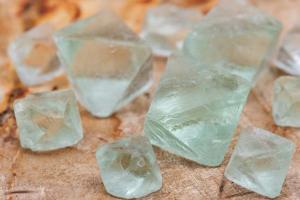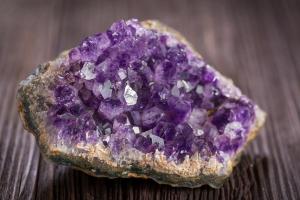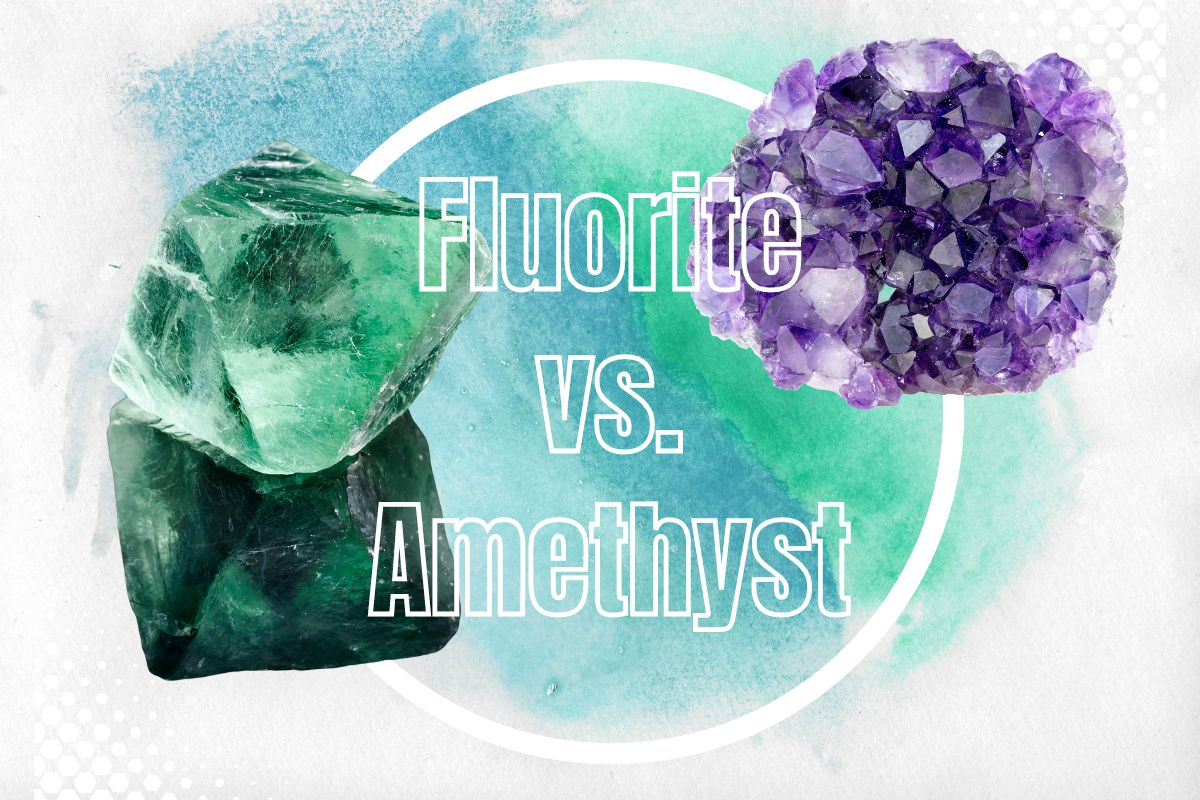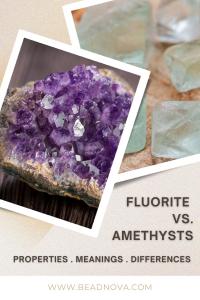In the world of gemstones and minerals, the differences between certain stones can be subtle, while the similarities are often striking. This article aims to explore the properties, meanings, and differences between two such minerals: fluorite vs. amethyst. As we delve into the fascinating world of these two beautiful stones, we will uncover what sets them apart and what connects them, while also discussing their historical and cultural significance.
Table of Contents
What is Fluorite?

Fluorite is a halide mineral composed of calcium fluoride (CaF2). It occurs in various colors, including green, purple, blue, yellow, and even colorless. This beautiful mineral is often used for ornamental purposes, but it also has practical applications in various industries, such as metallurgy and optics. In addition to its beauty and utility, fluorite has been prized throughout history for its various cultural and spiritual associations.
Fluorite in History and Culture
Historically, fluorite has been used by various cultures for both practical and spiritual purposes. Ancient Egyptians carved fluorite into statues and amulets, while the Chinese have used fluorite in carvings for centuries. In Europe, fluorite was employed as a flux in the production of steel and glass during the Industrial Revolution. Today, fluorite continues to be appreciated for its beauty and unique properties, finding its place in modern art, jewelry, and even technology.
Fluorite Meaning and Healing Properties
In metaphysical and spiritual circles, fluorite is known for its energy-clearing properties. It is believed to absorb and neutralize negative energy, making it an excellent tool for meditation and energy work. Fluorite is also said to enhance mental clarity and focus, helping individuals to make more informed decisions and better understand complex situations.
Fluorite in Energy Work
Fluorite is commonly used in energy work, such as crystal healing and Reiki. Practitioners believe that the stone’s unique vibrational frequency can help balance and align the body’s energy centers, or chakras. Some also use fluorite in the practice of feng shui, where it is thought to bring harmony and balance to living spaces.
Read more: Fluorite Meaning and Healing Properties
What is Amethyst?

Amethyst is a variety of quartz, a mineral composed of silicon dioxide (SiO2). It is characterized by its stunning violet color, which ranges from pale lilac to deep purple. The color of amethyst is attributed to the presence of trace amounts of iron in its crystal structure. This beautiful gemstone has been valued for centuries for its beauty and has played a significant role in various historical and cultural contexts.
Amethyst in History and Culture
Throughout history, amethyst has been associated with royalty, spirituality, and protection. In ancient Greece, it was believed to prevent drunkenness, and people would wear amethyst amulets or drink from amethyst-encrusted goblets to ward off intoxication. The gemstone has also been used by various religious and spiritual traditions, including Christianity, where it has been associated with piety and purity. Today, amethyst continues to be revered for its beauty and symbolism, often used in jewelry and decorative pieces.
Amethyst Meaning and Healing Properties
Much like fluorite, amethyst has a rich history in metaphysical and spiritual practices. It is known for its calming energy, which is believed to soothe the mind and emotions. This makes it an ideal stone for meditation and stress relief. In addition, amethyst is said to enhance intuition and spiritual awareness, helping individuals to connect with their higher selves and the spiritual realm.
Amethyst in Energy Work
Amethyst is frequently used in energy work and crystal healing practices. It is believed to help balance the third eye and crown chakras, promoting spiritual growth and a deeper connection to one’s intuition. Amethyst is also thought to protect against negative energy and psychic attacks, making it a popular choice for those seeking spiritual protection.
Read more: Amethyst Meaning and Healing Properties
How to Tell the Difference Between Fluorite and Amethyst?
In this section, we will explore the key differences between fluorite vs amethyst, examining their composition, appearance, hardness, value, and practical uses.
1.Fluorite and Amethyst: A Chemical Comparison
While both fluorite and amethyst are minerals, their chemical compositions differ significantly. Fluorite, as mentioned earlier, is composed of calcium fluoride (CaF2), while amethyst is a variety of quartz made of silicon dioxide (SiO2). This difference in composition impacts various properties of the two minerals, such as hardness and crystal habit.
2.Distinguishing Fluorite and Amethyst Visually
The most noticeable difference between fluorite and amethyst is their color. While fluorite can occur in a range of colors, including green, purple, blue, and yellow, amethyst is always some shade of purple. Moreover, the crystal habit of fluorite typically consists of cubic or octahedral shapes, whereas amethyst usually forms prismatic crystals with a six-sided pyramid at the termination.
3.Comparing Hardness of Fluorite and Amethyst
On the Mohs scale of mineral hardness, fluorite ranks at a relatively low 4, while amethyst has a higher hardness of 7. This difference in hardness affects their durability and applications. Fluorite is more prone to scratches and damage due to its lower hardness, making it less suitable for certain types of jewelry or high-traffic areas in home décor. In contrast, amethyst, with its greater hardness, is more resistant to wear and tear, making it a popular choice for various types of jewelry and decorative pieces.
4.Fluorite and Amethyst: Assessing Their Worth
The value of both fluorite and amethyst depends on factors such as color, clarity, cut, and carat weight. Generally, amethyst is considered more valuable than fluorite, due to its greater hardness, durability, and widespread popularity. However, some exceptional specimens of fluorite can fetch high prices, especially if they exhibit rare colors or crystal formations. The availability of the minerals in the market also plays a role in their value, with amethyst being more readily available than some varieties of fluorite.
5.Applications of Fluorite and Amethyst
Both fluorite and amethyst have various practical uses beyond their aesthetic appeal. Fluorite, with its ability to transmit a wide range of light frequencies, has applications in optics, such as in the manufacturing of lenses and optical fibers. It is also used as a flux in the production of certain metals. Amethyst, while less widely used in industrial applications, is frequently employed in jewelry and decorative items due to its beauty and durability.
Conclusion
In conclusion, both fluorite and amethyst are fascinating minerals with unique properties, meanings, and healing potentials. While they share some similarities, such as their use in meditation and energy work, their differences in composition, appearance, hardness, value, and practical uses set them apart. We hope that this comprehensive exploration of fluorite vs amethyst has provided you with valuable insights and inspired you to delve deeper into the world of crystals and their potential benefits.
In addition to their metaphysical properties, fluorite and amethyst have played significant roles in various historical and cultural contexts. From ancient Egypt to modern crystal healing practices, these minerals have captivated the hearts and minds of people across generations.
Whether you’re looking to enhance your spiritual practice, incorporate these minerals into your daily life, or simply appreciate the beauty of these natural wonders, both fluorite and amethyst have much to offer. By understanding the unique qualities of each mineral, you can make informed decisions about which stone best aligns with your personal preferences and needs. Ultimately, the world of gemstones and minerals is vast and diverse, with each stone offering its own unique charm and allure.
More articles about Gemstones you may like:
The Ultimate Guide to Use Healing Crystals for Beginner
Which Hand to Wear Your Crystal Bracelet?
What Crystals Work Well Together? 16 Crystal Combinations Ideas for Different Intentions
Which Stones Should Not Be Worn Together?
Selenite vs. Clear Quartz: What’s the Difference?
Black Tourmaline Vs. Black Obsidian: What’s the Difference?
Red Agate Vs. Carnelian: What’s The Difference?
Pink Calcite Vs. Rose Quartz: What’s The Difference?





Leave A Comment